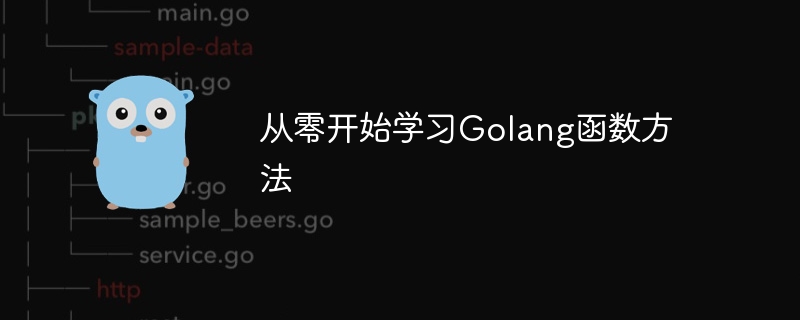Home >Backend Development >Golang >Learn Golang function methods from scratch
Learn Golang function methods from scratch
- PHPzOriginal
- 2024-03-12 18:33:04980browse

Title: Learning Golang function methods from scratch
In the process of learning the Golang programming language, mastering function methods is a very important part. Functions are basic structures used in programming to encapsulate reusable code, while methods are functions associated with a specific type. Through the guidance and specific code examples in this article, you will be able to learn Golang function methods from scratch and gradually master its basic principles and applications.
1. Function definition and calling
First, let us take a look at how to define and call functions in Golang. The basic syntax of the function is as follows:
func functionName(parameters) returnType {
// 函数体逻辑
} Among them, func is the keyword to define the function, functionName is the name of the function, parameters is the function parameter list, returnType is the type of function return value. The following is a simple example:
package main
import "fmt"
func greet(name string) {
fmt.Println("Hello, " + name + "!")
}
func main() {
greet("Alice")
}Running the above code will output Hello, Alice!. This example shows how to define a simple function and call it in the program.
2. Multiple return values of functions
In Golang, functions can return multiple values, which is a feature that some other programming languages do not have. For example:
func divide(dividend, divisor float64) (float64, error) {
if divisor == 0 {
return 0, errors.New("division by zero")
}
return dividend / divisor, nil
}In the above example, the divide function returns two values, one is the calculation result and the other is the possible error. By using the feature of multiple return values, it is easier to handle error conditions that may occur in functions.
3. Method definition and invocation
In Golang, a method is a function associated with a type. Here is a simple example of types and methods:
package main
import "fmt"
type Rectangle struct {
width float64
height float64
}
func (r Rectangle) area() float64 {
return r.width * r.height
}
func main() {
rect := Rectangle{width: 10, height: 5}
fmt.Println("Area:", rect.area())
}In the above code, a Rectangle type and an area method are defined. In the main function, a Rectangle instance is created and its area method is called to calculate the area.
4. Method pointer receiver
In Golang, you can use pointer receivers to modify the value of the method receiver. For example:
package main
import "fmt"
type Counter struct {
count int
}
func (c *Counter) increment() {
c.count++
}
func main() {
counter := Counter{count: 0}
counter.increment()
fmt.Println("Count:", counter.count) // 输出 1
}In the above example, the receiver of the increment method is the pointer of the Counter structure. After calling the increment method in the main function, the count value of the Counter instance is incremented.
Through the above examples and explanations, I believe you already have a preliminary understanding of function methods in Golang. Through continuous practice and learning, you will be able to use functional methods more skillfully to write efficient and flexible Golang programs. I wish you success in learning and exploring Golang!
The above is the detailed content of Learn Golang function methods from scratch. For more information, please follow other related articles on the PHP Chinese website!

